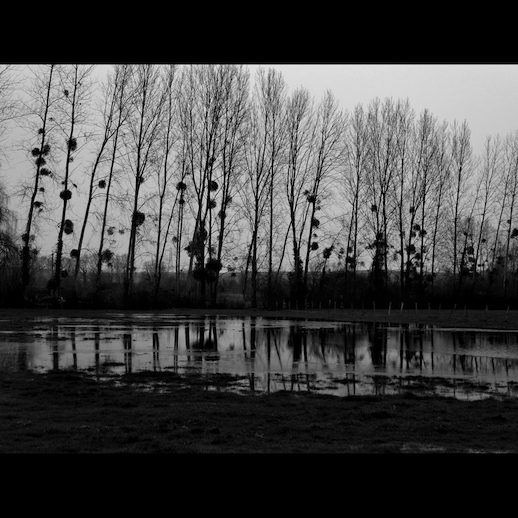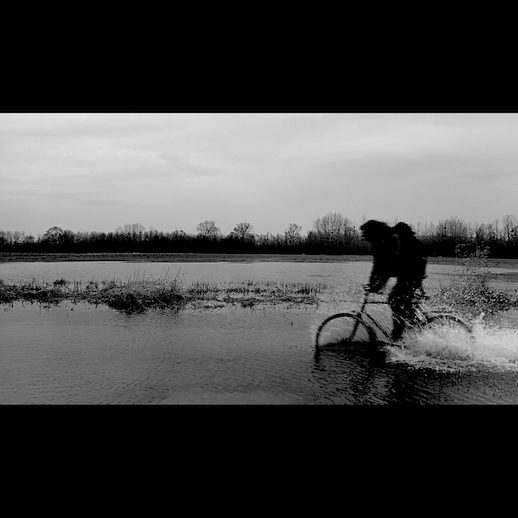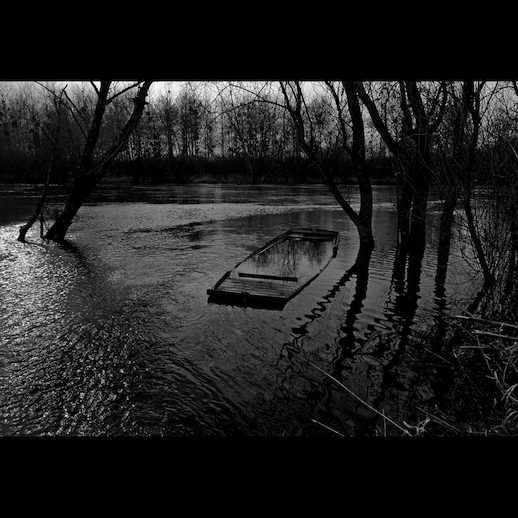Experimental field recordist extraordinaire Kate Carr was first brought to our attention by Cheryl Tipp, who featured her writing in An Antidote To Indifference Issue 13: Field Recording Special #2. We rather liked the cut of Kate’s jib: so much so, in fact, that we invited her to write this month’s Pleasures column. Lo and behold…
April was a month of watery excess.
Last year at around this time I spent a month recording the temporary wetlands of Marnay-sur-Seine just after the flooding of the river. Eventually this audio material, full of crackling power lines, water birds, hooting owls and the high pitched whine of nuclear towers turned into my album I had myself a nuclear spring. This year I was determined to return to Marnay to document the highest peak of the rising Seine, and by absolute luck my timing was perfect.
Marnay is a tiny town of about 200 people in the champagne district of France, about 120 kilometres east of Paris. It sits next to a large nuclear power plant, and each year as the Seine floods temporary wetlands see hundreds of water birds arriving into this rather surreal landscape to nest. Although in so many ways I can’t claim to know Marnay well, to me it is a town of extremes. There are no shops, no bars, no cafés or corner stores, and, most shockingly for the French, no bakeries. There is an unused dusty church, which marks time with its mechanically rung bell every half-an-hour from 7am until 10pm, when all the street lights turn off.
The woodlands surrounding Marnay are mostly plantation forests logged regularly, and peppered with scruffy hunting lodges used by some of Marnay’s residents to hunt boar and pheasants. Full of mud, water, rusting machinery, old boats, logs, and birds, it is a place by turns spectacular, eerie and ugly. While I was in Marnay many of the roads into the town were closed, having been flooded with water up to about chest height and the many dirt tracks through the forest were transformed into fast flowing streams. Apart from boat the best way to ford these flooded tracks was by bicycle, which suited me just fine. I procured myself a rusty bike and spent the next three weeks slipping, sliding, falling and wading through bogs, ponds, flooded fields, and surging streams.
Perhaps I tend towards the overly dramatic, but it is quite an experience to spend three weeks wading and attempting to cycle through freezing water alone in flooded woodlands. I found myself thinking a lot about the emotional efficacy of landscapes of excess, and the ways we use water as a metaphor for a vast array of feelings. Water has inundated our language. There is a watery word which can adequately serve for almost every emotional state we can imagine. The happy tinkle of a mountain stream, the drama of stormy seas, murky depths, and turbulent rivers. Water is unknowable and uncontainable – it floods and overflows, forms whirlpools and eddies. It surges, and runs away. It buffets the shore, it erodes and overwhelms. Water leaves us to drown, float, sink or swim. It cleanses and redeems; it stagnates and threatens.
Water also gives us a rich array of metaphors for struggle, risk and release. We tread water, we swim against the tide. We might be swept away, or catch a wave to shore. We jump in the deep end, or simply dip our toe in. I listened to quite a lot of pop music riding the flooded forest paths of Marnay, and I was struck by how many of them contained lyrics pertaining to water. ‘Don’t know where I’m going, don’t know where it’s flowing, but I know I’m finding you,” sang the Go-Betweens, a band from my hometown of Brisbane, Australia, as I splashed my way around. The language of water is the language of movement, of change, of dreams, of love, of emotion, of risk and of despair. It gives us the language for a life well lived I think.
Last time I was in Marnay I was looking for interesting field recordings, so I spent a lot of time wandering around at dusk when the birds were most vocal, and at night when the soundscape turned mysterious, with throbbing trains, owls and restless ravens. But this time around I was trying to gather photographs and video footage, in part to make a film clip for one of the Nuclear Spring pieces, and this meant I spent a lot more time out and about in the day time. In addition to my usual camera, I have recently got a new underwater camera and I became obsessed with trying to capture Marnay’s temporary watery world from both above and underwater. I’m no expert at underwater photography, but my short exposure to it has left me dazzled by the beauty of the combination of sun and water. Sun hitting water and separating into distinct rays, light reflecting off the churning river, sun dappled underwater scenes. My rudimentary techniques at capturing such images consisted of simply wading into streams and holding the camera underwater, which left me yelling with pain at my numb hands, or tying a string to the camera and throwing it into streams. It was a rather hit and miss approach.
But it was perhaps my exposure to the best of these images which saw water seep into my dreams. In Marnay almost all my dreams were set underwater. I met friends underwater, conducted love affairs underwater, caught the TGV underwater, ate French cheese and black radishes underwater. I even stressed out about how to capture better underwater films underwater. While my days were filled with mud, freezing streams, precarious bicycle rides and shoes filled with water, as soon as my head hit the pillow, everything was tinged with dappled sunlight set to a green hue, and where ever I looked the light separated into distinct rays. It was a beautiful way to exist.
Kate will be joining us at The Good Life Experience, 16-18 September. More information here.


